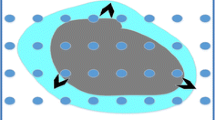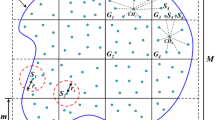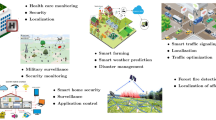Abstract
In a resource-constrained wireless sensor network, energy efficiency is a principle issue for monitoring the movement of continuous objects, such as wild fire and hazardous chemical material. In this paper, a continuous object tracking scheme with two-layer grid model (TGM-COT) is proposed. To address the problem of boundary distortion caused by uneven node distribution, we put forward a novel mechanism for boundary nodes identification. Furthermore, a streamlining mechanism is designed to reduce the amount of uploaded data. Simulation results demonstrate that, without sacrificing additional energy consumption, TGM-COT is able to achieve high tracking accuracy and significantly reduce the communication overhead.














Similar content being viewed by others
References
Han G, Jiang J, Shu L, Xu Y, Wang F (2012) Localization algorithms of underwater wireless sensor networks: a survey. In: Sensors (Basel, Switzerland), pp 2026–2061
Baadache A, Adouane R (2015) Minimizing the energy consumption in wireless sensor networks. J Ad Hoc Sens Wirel Netw 27:223–237
Zhang D, Zhou J, Guo M, Cao J (2011) TASA: tag-free activity sensing using RFID tag arrays. IEEE Trans Parallel Distrib Syst 22:225–270
Zhao J, Mo L, Wu X, Wang G, Liu E, Dai D (2014) Error estimation of iterative maximum likelihood localization in wireless sensor networks. J Ad Hoc Sens Wirel Netw 23:277–295
Yingqi X, Winter J, Lee W-C (2004) Prediction-based strategies for energy saving in object tracking sensor networks. In: IEEE international conference on mobile data management, pp 346–357
Yingqi X, Winter J, Lee W-C (2004) Dual prediction-based reporting for object tracking sensor networks. In: Annual international conference on mobile and ubiquitous systems, pp 154-163
Chen WP, Hou JC, Sha L (2004) Dynamic clustering for acoustic target tracking in wireless sensor networks. IEEE Trans Mobile Comput 3:258–271
Liu BH, Ke WC, Tsai CH, Tsai MJ (2008) Constructing a message-pruning tree with minimum cost for tracking moving objects in wireless sensor networks is NP complete and an enhanced data aggregation structure. IEEE Trans Comput 57:849–863
Lazos L, Poovendran R, Ritcey JA (2007) Detection and tracking: probabilistic detection of mobile targets in heterogeneous sensor networks. In: International conference on information processing in sensor networks, pp 519–528
Song L, Hatzinakos D (2007) A cross-layer architecture of wireless sensor networks for target tracking. IEEE/ACM Trans Netw 15:145–158
Shrivastava N, Mudumbai R, Madhow U, Suri S (2006) Target tracking with binary proximity sensors: fundamental limits, minimal descriptions, and algorithms. In: International conference on embedded networked sensor systems, pp 251–264
Yueqin Z, Xiaopeng D (2010) Based on cluster cover algorithm in coal mine gas forecast application. In: 2010 International conference on intelligent computation technology and automation (ICICTA 2010), pp 854–857
Hajiaghajani F, Naderan M, Pedram H (2012) HCMTT: hybrid clustering for multitarget tracking in wireless sensor networks. In: Processing of 2012 IEEE international conference on pervasive computing and communications workshops, pp 889–894
Schurgers C, Tsiatsis V, Ganeriwal S, Srivastava M (2002) Topology management for sensor networks: exploiting latency and density. In: Processing of the third ACM international symposium on mobile ad hoc networking and computing (MobiHoc), pp 135–145
Liao PK, Chang MK, Kuo CJ (2004) Distributed edge detection with composite hypothesis test in wireless sensor networks. In: Processing of IEEE communication society Globecom, pp 129–133
Chang WR, Lin HT, Cheng ZZ (2008) CODA: a continuous object detection and tracking algorithm for wireless ad hoc sensor networks. In: Processing of the 5th IEEE consumer communications and networking conference (CCNC 2008), pp 168–174
Kim JH, Kim KB, Chauhdary SH, Yang W, Park MS (2008) DEMOCO: energy-efficient detection and monitoring for continuous objects in wireless sensor networks. IEICE Trans Commun E91-B:3648–3656
Park B, Park S, Lee E (2010) Large-scale phenomena monitoring scheme in wireless sensor networks. In: Processing of VTC 2010—Spring, pp 1–5
Hong SW, Noh SK, Lee E, Park S, Kim SH (2010) Energy-efficient predictive tracking for continuous objects in wireless sensor networks. In: Processing of PIMRC 2010, pp 1725–1730
Lee W, Yim Y, Park S (2012) Selective wakeup discipline for continuous object tracking in grid-based wireless sensor networks. In: IEEE Conference—WCNC wireless communication and networking, pp 2179–2184
Kim WS, Park HS, Lee JC (2012) Efficient continuous object tracking with virtual grid in wireless sensor networks. In: Processing of VTC 2012 Spring, pp 1–5
Jin DX, Chauhdary SH, Ji X (2009) Energy-efficiency continuous object tracking via automatically adjusting sensing range in wireless sensor network. In: Processing of the fourth IEEE international conference on computer sciences and convergence information technology, pp 122–127
US Naval Observatory (USNO) GPS Operations. http://tycho.usno.navy.mil/gps.html
Han G, Zhang C, Shu L, Rodrigues JJPC, Lloret J (2014) A mobile anchor assisted localization algorithm based on regular hexagon in wireless sensor networks. In: Processing of the Scientific World Journal
Hong H, Oh S, Lee J, Kim S (2013) A chaining selective wakeup strategy for a robust continuous object tracking in practical wireless sensor networks. In: Processing of 2013 IEEE 27th international conference on advanced information networking and applications (AINA), pp 333–339
Acknowledgments
The work is supported by “Qing Lan Project”, “National Science Foundation of China, Nos. 61572172 and 61401107”, “2013 Special Fund of Guangdong Higher School Talent Recruitment, Educational Commission of Guangdong Province, China Project No. 2013KJCX0131” and “Guangdong High-Tech Development Fund No. 2013B010401035”.
Author information
Authors and Affiliations
Corresponding author
Rights and permissions
About this article
Cite this article
Han, G., Shen, J., Liu, L. et al. TGM-COT: energy-efficient continuous object tracking scheme with two-layer grid model in wireless sensor networks. Pers Ubiquit Comput 20, 349–359 (2016). https://doi.org/10.1007/s00779-016-0927-7
Received:
Accepted:
Published:
Issue Date:
DOI: https://doi.org/10.1007/s00779-016-0927-7




